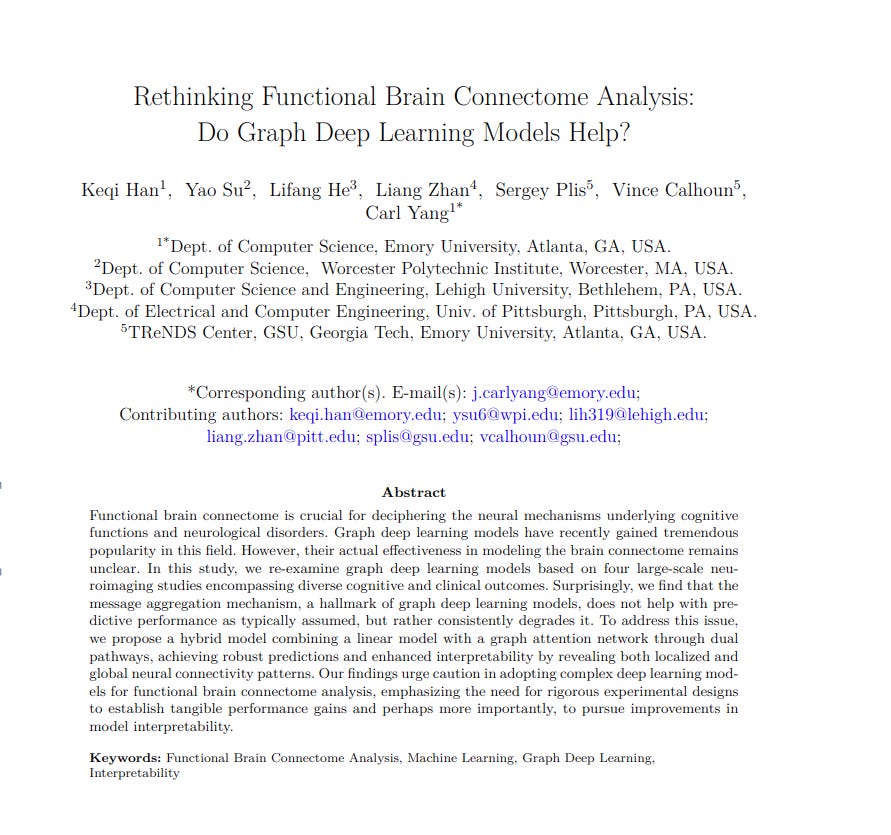"Rethinking Functional Brain Connectome Analysis: Do Graph Deep Learning Models Help?"
Below podcast on this paper is generated with Google's Illuminate.
https://arxiv.org/abs/2501.17207
This paper addresses the unclear effectiveness of Graph Deep Learning (GDL) models in functional brain connectome analysis compared to classical Machine Learning (ML) methods. It questions if the message aggregation in GDL truly benefits predictive performance.
To solve this, the paper proposes a dual-pathway model. This model combines a linear model and a graph attention network.
-----
📌 Dual-pathway model smartly uses linear model for global patterns and Graph Attention Network for local brain structure. This hybrid approach overcomes limitations of solely relying on message aggregation in Graph Deep Learning.
📌 BOLD time-series embeddings as node features in Graph Attention Network are key. They mitigate over-smoothing seen with connection profiles, enhancing the graph pathway's interpretability and effectiveness.
📌 The finding that message aggregation degrades performance challenges common Graph Neural Network assumptions in brain connectome analysis. It emphasizes careful feature selection and architecture design for neural data.
----------
Methods Explored in this Paper 🔧:
→ This paper benchmarks Graph Deep Learning models against classical Machine Learning models on four brain connectome datasets: ABIDE, PNC, HCP, and ABCD.
→ It evaluates various models including Logistic Regression, Kernel Ridge Regression, Multi-Layer Perceptrons, Graph Convolutional Networks, Graph Attention Networks and others.
→ The paper introduces a dual-pathway model to address the limitations of existing GDL methods.
→ This dual-pathway model consists of two pathways: a Linear Model pathway and a Graph Attention Network pathway.
→ The Linear Model pathway uses the flattened upper triangular part of the functional brain network matrix as input features.
→ The Graph Attention Network pathway uses embeddings of Blood-Oxygen-Level-Dependent time series as node features and processes them with a Graph Attention Network.
→ A phased training strategy is used to optimize both pathways effectively.
-----
Key Insights 💡:
→ Classical Machine Learning models like Logistic Regression and Kernel Ridge Regression often achieve comparable or superior predictive performance to complex Graph Deep Learning models.
→ Message aggregation, a core mechanism in Graph Deep Learning, can degrade prediction performance in functional brain connectome analysis when connection profiles are used as node features.
→ The proposed dual-pathway model, integrating both linear and graph-based approaches, achieves robust and competitive performance across diverse datasets.
-----
Results 📊:
→ On ABIDE dataset, dual-pathway model achieves AUROC of 0.732, while best baseline is 0.737.
→ On PNC dataset, dual-pathway model achieves AUROC of 0.834, outperforming best baseline at 0.827.
→ For HCP dataset, dual-pathway model achieves correlation of 0.247, with best baseline at 0.270.
→ On ABCD dataset, dual-pathway model achieves correlation of 0.358, exceeding best baseline at 0.348.


